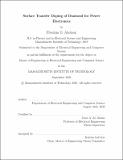Surface transfer doping of diamond for power electronics
Author(s)
Al Johani, Ebrahim Dakhil.
Download1227273886-MIT.pdf (12.71Mb)
Other Contributors
Massachusetts Institute of Technology. Department of Electrical Engineering and Computer Science.
Advisor
Jesus A. del Alamo.
Terms of use
Metadata
Show full item recordAbstract
The quest for a suitable wide-bandgap semiconductor for high-power and high-frequency applications is well motivated; wide-bandgap semiconductors generally exhibit a high breakdown field and can therefore support a high voltage over short distances. Diamond (Bandgap of 5.5 eV) in particular is an attractive prospect since its thermal conductivity and radiation hardness well surpass other wide-bandgap semiconductors. However, practical transistors require the ability to engineer the charge density through substitutional doping which has proven to be difficult considering the strong covalent bonds that make up bulk diamond. In this work, we utilize hydrogen-passivated diamond surface along with surface acceptors to generate a highly conductive 2D hole sheet at the surface with carrier densities going up to 10¹⁴ cm⁻². Surface transfer doping using stable high electron affinity transition-metal oxides (TMO) such as WO₃ in conjunction with the novel contact-first process explored in this work shows great promise on advancing process stability while attaining the high current densities desired in the future of power diamond transistors. We closely examine the H-terminated diamond/TMO interface using a numerical approach based on a Schrödinger-Poisson solver package. We identify key inconsistencies in the generic valence-to-conduction transfer model for both shallow and deep TMO electron affinity regimes. We report that introducing deep level impurities in the TMO have shown improvements to the effect of bias modulation and agreement with experiments for low TMO affinities. A solution for engineering a preexisting TMO with fixed affinity and trap level is presented through TMO thickness engineering. The methods explored in this work show promise towards the enhancement of diamond conductivity and reproducibility.
Description
Thesis: M. Eng., Massachusetts Institute of Technology, Department of Electrical Engineering and Computer Science, September, 2020 Cataloged from student-submitted PDF of thesis. Includes bibliographical references (pages 77-80).
Date issued
2020Department
Massachusetts Institute of Technology. Department of Electrical Engineering and Computer SciencePublisher
Massachusetts Institute of Technology
Keywords
Electrical Engineering and Computer Science.